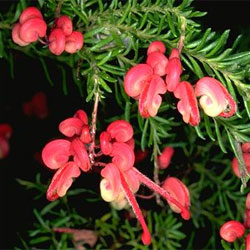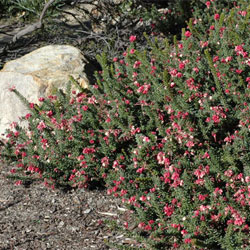Grevillea lanigera
Woolly Grevillea
Grevillea lanigera A.Cunn. ex R.Br.
 Grevillea lanigera occurs in south eastern New South Wales extending through the A.C.T. to the Bathurst region and from Wilsons Promontory in Victoria to the north east corner and into the high country. It grows in a wide range of habitats, usually eucalypt woodland and medium scrub, sometimes in coastal heath. It flowers all year, mainly in winter and spring. It is pollinated by birds and regenerates from seed or suckers.
Grevillea lanigera occurs in south eastern New South Wales extending through the A.C.T. to the Bathurst region and from Wilsons Promontory in Victoria to the north east corner and into the high country. It grows in a wide range of habitats, usually eucalypt woodland and medium scrub, sometimes in coastal heath. It flowers all year, mainly in winter and spring. It is pollinated by birds and regenerates from seed or suckers.
The common name Woolly Grevillea refers to its hairy branchlets and leaves. Grevillea lanigera is a variable species, usually a suckering or prostate to erect shrub to 1.5 m tall. The flowers are bright pink or red-pink and cream, sometime creamy green or yellow,
The prostrate form is the best known in cultivation and usually called the ‘Mt Tamboretha form' although this form apparently does not occur in that location. This form has proven to be hardy in a range of climates provide the soils are well drained. Grevillea lanigera prefers sunny or semi-shaded situations and withstands extended dry periods once established. It does not need summer watering and fertilizer also is not usually necessary. Occasional light pruning enhances shape and density. Seed sets good quantities of seed that germinates well when pretreated.
Text by Nonglak Sopakayoung (2011 Student Botanical Intern)
Name Meaning: Grevillea lanigeraGrevillea – named after Charles Francis Greville (1749–1809), co-founder of London Horticultural Society, a patron of botany. lanigera – from the Latin ‘lana’ meaning wool and ‘ger’ meaning bearing. |
References
Costermans, L. (2009) Native trees and shrubs of South-Eastern Australia. New Holland Publishers (Australia) Pty Ltd, Sydney
Greig, D. (2009) Field guide to Australian wild flowers. New Holland Publishers (Australia) Pty Ltd, Sydney.
Mulvaney, M. (2011) Horticulturist, Australian National Botanic Gardens. Pers. comm.
![An Australian Government Initiative [logo]](/images/austgovt_brown_90px.gif)



